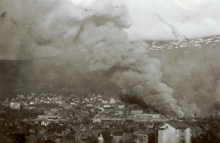Narvik (town)
Narvik | |
|---|---|
Narvik Municipality | |
| Established | 1 Jan 1902 |
| Area | |
| • Total | 6.93 km2 (2.68 sq mi) |
| Elevation | 87 m (285 ft) |
| Population (2023)[1] | |
| • Total | 14,051 |
| • Density | 2,028/km2 (5,250/sq mi) |
| Demonyms | Narviking Narvikværing |
| Time zone | UTC+01:00 (CET) |
| • Summer (DST) | UTC+02:00 (CEST) |
| Post Code | 8514 Narvik |
Narvik is a
The 6.93-square-kilometre (1,710-acre) town has a population (2023) of 14,051 which gives the town a population density of 2,028 inhabitants per square kilometre (5,250/sq mi).[1]
Narvik Church is the main church for the town. Narvik is a commercial centre for the region. Narvik University College has approximately 1,200 students. There are some high-tech businesses in Narvik (among them Natech).
Etymology
Narvik is named after the old Narvik farm ("Narduigh" – 1567), since the town is built on its ground.[4]
The
The port was originally called Victoriahavn after
History



The history of Narvik as a settlement began in the
Narvik was developed as an all-year
Swedish mining corporation LKAB still ships the majority of its ore from Narvik (a total 25 million tons a year). The corporation is still important in the area, both as an employer and landowner, although its influence is not as prominent now as it has been in previous years.[7]
The town of Narvik was established on 1 January 1902 when the village of Narvik received status as a proper town and was separated from the large municipality of Ankenes so it could have its own municipal government. Initially, the town-municipality of Narvik had 3,705 residents. On 1 January 1974, the municipality of Ankenes was merged with the town-municipality of Narvik, forming a new, larger municipality of Narvik.[8]
World War II

(Borders as of 1920–1940)


The port of Narvik proved to be strategically valuable in the early years of
Churchill proposed laying a naval minefield in Norwegian territorial waters around Narvik (referred to as "the Leads")[9] or else occupying the town with Allied troops. The Allies hoped that they might be able to use an occupied Narvik as a base from which to secure the Swedish ore fields and/or to send supplies and reinforcements to Finland, then fighting the Finnish Winter War with the Soviet Union. Plans to lay a minefield around Narvik or to seize the town met with debate within the British government – since both plans would mean a violation of Norway's neutrality and sovereignty.[9]
Finally, on 8 April 1940, the
On 12 April 1940, the first convoys of Allied soldiers were sent under Major-General Pierse Joseph Mackesy to Narvik. The Admiralty urged Mackesy to conduct an assault on Narvik from the sea as soon as possible. However, Mackesy believed that the German harbour defences were too strong for such an invasion to take place. The Admiralty argued that a naval bombardment of Norway would enable the troops to land safely, but General Mackesy refused to subject Norwegian citizens to such a bombardment and instead he chose to land his troops near Narvik and wait until the snow melted to take over the town.[9]
Coordinated by the Norwegian
Possession of the
See also
References
- ^ a b c Statistisk sentralbyrå (1 January 2023). "Urban settlements. Population and area, by municipality".
- ^ "Narvik (Nordland)". yr.no. Retrieved 8 January 2019.
- Store norske leksikon (in Norwegian). Kunnskapsforlaget. Retrieved 8 January 2019.
- ^ Rygh, Oluf (1905). Norske gaardnavne: Nordlands amt (in Norwegian) (16 ed.). Kristiania, Norge: W. C. Fabritius & sønners bogtrikkeri. p. 285.
- Store norske leksikon. Retrieved 26 February 2024.
- ^ "Key facts about Narvik". VisitNorway.com. Retrieved 24 November 2008.
- ^ a b "Narvik, Norway". BBC. Retrieved 24 November 2008.
- ^ Jukvam, Dag (1999). "Historisk oversikt over endringer i kommune- og fylkesinndelingen" (PDF) (in Norwegian). Statistisk sentralbyrå.
- ^ ISBN 978-0-395-41055-4.
- ISBN 978-0-89966-728-7.


